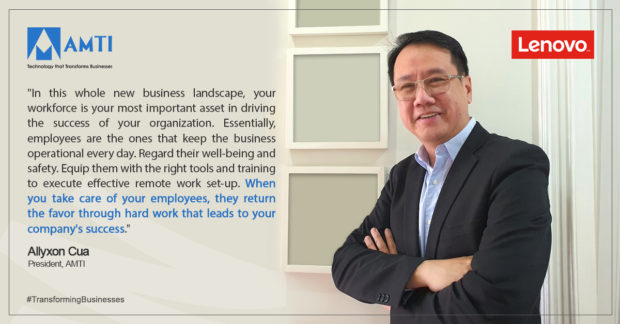Turning the COVID-19 challenge into viable business transformation
In the wake of the on-going pandemic, experts consider it as the biggest experimental run on remote working. In the past, if you will ask businesses to shift to remote working, they will be hesitant to implement it in their company as it is something unimaginable for them since it requires a new way of working and investment in technologies. The business outcome for such change is a gamble for them. But as soon as the pandemic and lockdown measures impacted the way we do our usual work, everyone was required to shift and implement remote working overnight—whether they were ready for it or not. These companies struggled to survive and quickly looked for devices to equip their workforce.
But much has been changed in the past months. When the government slowly eased the community quarantine to boost once again the declined economic activities, several businesses required their employees to go back to their physical offices. These businesses perhaps might be worried that remote work cannot work for them for a long time due to budget or lack of devices. But speaking the truth, even if there are safety protocols in the workplace, the exposure to the virus are faint and uncertain. When possible, remote working is highly encouraged to reduce the foot traffic in public and keep the workforce safe at the comfort of their own homes.
“For businesses, rather than seeing it as a difficulty, it can be an opportunity to re-strategize business operations and adapt to remote working,” said Mr. Allyxon Cua, President of AMTI, one of the most diversified ICT companies in the Philippines and a Digital Transformation enabler. As one of the few companies that remained operational and implemented remote working until today, Mr. Cua attested that although at first there are uncertainties on the possible outcomes of remote working, their distributed workforce demonstrated resiliency and increased productivity even more so than before. “With the right mindset and right technologies to execute remote working efficiently, surprisingly, we were able to operate effectively and stay profitable while our employees were working from home safe and sound, as well as attend to the immediate needs of our customers,” Mr. Cua added. As a result of this initiative and synergy, their company delivered outstanding business performance.
What should businesses understand to achieve an efficient remote work setting? Perhaps it is the leadership—empowering a cultural change in the workplace and embracing innovation to drive the company forward. If business leaders stay behind and refuse to accept change, it can lead to a downfall—affecting the whole business—from its operations, workforce, stakeholders, to its customers.
“But in this significant change in the business world, your employees are your most important asset in driving the success of your organization. Essentially, employees are the ones that keep the business operational every day. Regard their well-being and safety. Equip them with the right tools and training to execute effective remote work set-up,” said Mr. Cua. Shifting to a new work environment requires workforce consideration as well. Consider what suitable devices and work set-up that best works for them. Companies must create a work setting that not only focuses on efficiency and collaboration but the safety and well-being of the employees as well. “When you take care of your employees, they return the favor through hard work that leads to your company’s success,” he added.
Providing remote work tools such as laptops helps bring out the best performance of the employees. But the quality and value of these devices vary from what kind of work and employee persona one’s business has. Other than that, it is vital to equip employees with fast and durable laptops to handle daily workloads. The pandemic taught us, whether, in the office or a remote work setting, laptops made it possible to work anytime and anywhere. But rather than the capital expenditures (CAPEX) model in procuring laptops, business experts suggests investing in operating expenditures (OPEX) instead to help businesses reduce financial burdens and allocate it to other business development plans.
Today, we are witnessing how work-from-home or remote work set-up keeps some companies operational. Some even settled that such work setting will be permanent for their business, perhaps until our world gradually overcomes the adversity brought by the pandemic. But the thought of ‘normal life’ appears to be far from over. The new era of business we face now is all about the usage of digital and remote enabling technologies. Rather than companies risking going back to their physical offices or thinking how and when they should be able to return then office, leaders should foresee the future of work, empower change, and adapt to it.
AMTI, together with Lenovo, provides businesses with suitable laptops and other devices that meet their remote work needs to emerge and be successful in this COVID-19 era. The Lenovo ThinkPad® laptops fit the different employee persona and business environment to ensure one’s business workforce can efficiently work just as they would do in the office.
—
Talk to AMTI now to help you analyze your current business situation and remote work readiness to come up with recommendations and solutions tailored for your business. Send your inquiries at https://amti.com.ph/contact-us/ or email us at inquiries@amti.com.ph
Follow AMTI on Facebook and LinkedIn for more technology updates.
ADVT.
